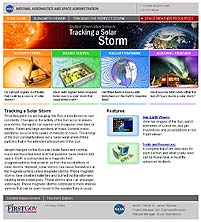Sun-Earth Day Presents: Ancient Observatories, Timeless Knowledge

Tracking a Solar Storm
This year's Sun-Earth Day theme, "Ancient Observatories, Timeless Knowledge", has been created to take you on an exciting journey through centuries of Sun-Watching. Throughout time human beings from diverse cultures have viewed the Sun as the source of life and have used technology to understand the Sun and the Universe beyond. Today NASA provides additional tools for examining the Sun and its effect on Earth. The Student Observation Network: Tracking a Solar Storm program collects and organizes data from many NASA missions into learning modules that make it easy for students to engage in inquiry.
The Goal
"Tracking a Solar Storm" is designed to engage students in Grades 4-12 in scientific investigations that allow them to construct an understanding of the processes described above by:
- Making observations of the Sun
- Tracking Solar Storms
- Using scientific data
- Making predictions
- Conducting on-line collaborations
The Structure
This module has been carefully constructed to follow the sequence of events of a Solar Storm. It explores the essential question: How do we know when the next solar storm will affect Earth? "Tracking a Solar Storm" contains four programs, each designed to answer separate questions that, together, contribute to answering the essential question. This structure allows you to use the "Jigsaw Method" To facilitate guided inquiry of "Tracking a Solar Storm", begin with Sunspotters, proceed to Radio Waves, followed by Magnetosphere, and finally Auroral Friends. Used in this order you will more closely follow the sequence of events of a solar storm.
